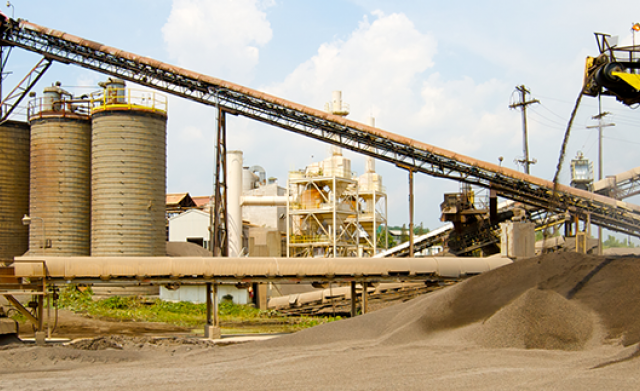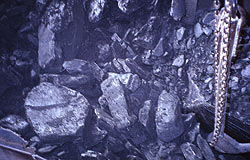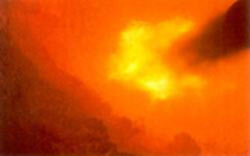
Mining
The raw material for Norlite is a thick sequence of shale, approximately 450 million years old, known as the Normanskill Shale. The rock is an exceptionally uniform, dark gray to black, very fine-grained shale with occasional thin, discontinuous beds of mudstone and siltstone.
Extensive drilling as well as regional geologic relationships demonstrate the uniformity of the shale and its extreme thickness, estimated to exceed 3,000 feet. The quarry is assured of a long-term supply of uniform quality raw material to maintain the feed for high quality lightweight aggregate.
The shale deposit is broken into manageable pieces by drilling and blasting. The broken shale is then loaded into off-road dump trucks for transportation out of the quarry to the primary crushing operation.
Primary Crushing and Screening
 The material that arrives from the quarry is dumped directly into a rock box and then fed through a vibrating grizzly feeder and into the primary jaw crusher. The material then exits the jaw crusher and is fed to a 6x20 horizontal screen. The screen takes the material that is large than 2 inches and feeds it to a secondary cone crusher. From the cone it is fed back to the screen. On the screen the material that is smaller than 3/8 of an inch is removed from the system and sold as normalweight road base. The material that is smaller than 2 inches and bigger than 3/8 of an inch is placed into a storage silo for feed to the rotary kilns.
The material that arrives from the quarry is dumped directly into a rock box and then fed through a vibrating grizzly feeder and into the primary jaw crusher. The material then exits the jaw crusher and is fed to a 6x20 horizontal screen. The screen takes the material that is large than 2 inches and feeds it to a secondary cone crusher. From the cone it is fed back to the screen. On the screen the material that is smaller than 3/8 of an inch is removed from the system and sold as normalweight road base. The material that is smaller than 2 inches and bigger than 3/8 of an inch is placed into a storage silo for feed to the rotary kilns.
Expansion
The sized raw shale is then discharged at a controlled rate from the storage silo and fed into one of the two rotary kilns. The kilns are 11 feet in diameter by 175 feet long. The shale is introduced into the back end of the kiln at a temperature of approximately 800 degrees Fahrenheit. Initially the moisture in the shale is evaporated and the shale begins to preheat as it moves forward in the kiln. The shale is retained in the kiln for approximately 45 minutes. As the shale approaches the front of the kiln, where the burner is located, the temperature increases. The shale enters the portion of the kiln called the Burning Zone. In the Burning Zone the temperature is maintained at 2000 to 2100 degrees Fahrenheit.

At this temperature the shale reaches what is known as the point of incipient fusion where the shale is in a semiplastic state. At this point, entrapped gases are formed and expansion results creating individual non-connecting air cells. The expanded shale is then discharged from the kiln onto an air quenched traveling grate cooler. The cooler serves two purposes. One is to cool the newly expanded shale down so it can be easily handled by conventional means, and the other purpose is to preheat the large volumes of air that are needed in the process. The cooled vitreous clinker is discharged from the cooler onto an 18 inch belt for stockpile storage.
Crushing and Storage
The clinker is fed to an underground feeder and then conveyed to a 6’x20’ inclined screen deck. Different cuts are taken at the screen to produce a consistent quality product. The oversize is fed to a cone crusher for further reduction and then fed back to the screen. Quality control checks are taken to ensure properly graded products are being manufactured. The material is conveyed to separate stockpiles for distribution to customers.
Shipment
Norlite is available for shipment in bulk by rail, truck or barge, in the following sizes:
- (Structural) 3/4" x No.4, 3/8" x No.8, and 3/16,
- (Fines) 3/8” x 0, No.4 x 0, and No.8 x 0.
